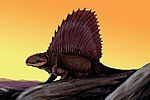User:Abyssal/Portal:Permian
|
IntroductionSelected article on the Permian world and its legacies
A fish is any member of a paraphyletic group of organisms that consist of all gill-bearing aquatic craniate animals that lack limbs with digits. Included in this definition are the living hagfish, lampreys, and cartilaginous and bony fish, as well as various extinct related groups. Most fish are ectothermic ("cold-blooded"), allowing their body temperatures to vary as ambient temperatures change. Fish are abundant in most bodies of water. They can be found in nearly all aquatic environments, from high mountain streams to even hadal depths of the deepest oceans. At 32,000 species, fish exhibit greater species diversity than any other group of vertebrates. Because the term "fish" is defined negatively, and excludes the tetrapods (i.e., the amphibians, reptiles, birds and mammals) which descend from within the same ancestry, it is paraphyletic, and is not considered a proper grouping in systematic biology.
The earliest organisms that can be classified as fish were soft-bodied chordates that first appeared during the Cambrian period. Although they lacked a true spine, they possessednotochords which allowed them to be more agile than their invertebrate counterparts. Fish would continue to evolve through the Paleozoic era, diversifying into a wide variety of forms. Many fish of the Paleozoic developed external armor that protected them from predators. The first fish with jaws appeared in the Silurian period, after which many (such as sharks) became formidable marine predators rather than just the prey of arthropods. (see more...) Did you know?
Need help?Do you have a question about Abyssal/Portal:Permian that you can't find the answer to? Consider asking it at the Wikipedia reference desk. Selected image
Selected article on the Permian in human science, culture and economics
Bone Sharps, Cowboys, and Thunder Lizards: A Tale of Edward Drinker Cope, Othniel Charles Marsh, and the Gilded Age of Paleontology (2005) is a graphic novel written by Jim Ottaviani and illustrated by the company Big Time Attic. The book tells a slightly fictionalized account of the Bone Wars, a period of intense excavation, speculation, and rivalry which led to a greater understanding of dinosaurs in the western United States. This novel is the first semi-fictional work written by Ottaviani; previously, he had taken no creative license with the characters he depicted, portraying them strictly according to historical sources.
Bone Sharps follows the two scientists Edward Drinker Cope and Othniel Marsh as they engage in an intense rivalry for prestige. Ottaviani has Cope and Marsh interact and meet many important figures of the Gilded Age, from P. T. Barnum to U.S. Grant, as the two scientists pursue their hotheaded and sometimes illegal acquisitions of fossils. Unlike in his previous books, "the scientists are the bad guys this time". Upon release, the novel received praise from critics for its exceptional historical content, although some reviewers wished more fiction had been woven into the story. (see more...) GeochronologyEpochs - Cisuralian - Guadalupian - Lopingian Geography - Pangaea - Panthalassa Stratigraphic units - Red Beds of Texas and Oklahoma Researchers - Edward Drinker Cope SubcategoriesQuality ContentFeatured Permian articles - Amphibian Things you can doRelated contentAssociated WikimediaThe following Wikimedia Foundation sister projects provide more on this subject:
|























